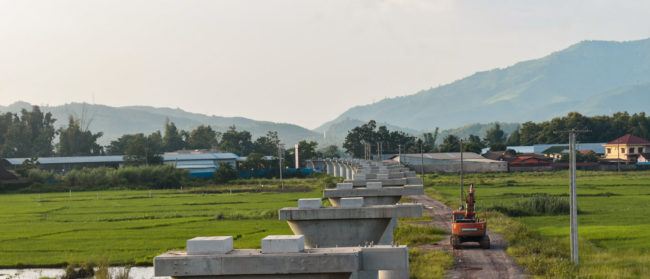Phnom Penh, with its shrinking green spaces and rampant real-estate development, is not a city governed with the welfare of its residents in mind.
Smoke on the Water – a report released last week by several NGOs, also picked up by international press – offered merely the most recent evidence of this, highlighting the more than one million of the capital’s residents set to suffer the environmental consequences of vital wetlands being filled in to make way for development projects.
Opening the report was a quote in bold 26-point font referencing Vann Molyvann – the visionary state architect who shaped the landscape of post-colonial Cambodia – reading “[…] cities should be built not by landfill but by incorporating water into their design”.
A fitting quote, perhaps, because of another development on Phnom Penh’s (cultural) landscape in recent weeks.
Originally published late last month on a Cambodian real estate website, later republished by the Khmer Times, was an real estate listing-cum-editorial enticing readers with the opportunity to “Own an icon of New Khmer Architecture”.
The icon in question is the former Molyvann residence, a striking orange-clad structure featuring his signature blend of Le Corbusier-esque modernism infused with Cambodian tradition, built in 1966 on Mao Tse Toung boulevard.
“To own such a unique piece of Cambodian history,” the piece writes, “grants its owners the unique leverage of an almost guaranteed increase in value over time”.
But with all this talk of price per square metre and investment potential, there seems to be virtually no public discussion regarding preserving, and even celebrating, this landmark of immense Cambodian heritage.

A “masterpiece of home design” and a “reminder of Cambodia’s rich intellectual prowess” are phrases used by the estate agents to attract suitors to the Molyvann residence – the $7 million-listed structure’s historic and cultural significance not lost on those tasked with selling it.
But a small and, these days, rundown residence occupying a prime plot of land on one of Phnom Penh’s major arteries, there’s no guarantee that the home’s next owners will prioritise its intangible cultural value over the plot’s very tangible economic one.
Cambodia’s rapidly modernising landscape, too, offers little in the way of comfort on that front for any would-be architectural conservationists.
Several historic structures in Phnom Penh, with no purpose-built legislation in place to preserve them, have made way in the name of development in recent decades, most prominent among them some of Molyvann’s own creations.
The Frank Lloyd Wright-inspired Preah Suramarit National Theatre, reportedly Molyvann’s favourite creation, was demolished in 2008 at the hands of tycoon Kith Meng’s The Royal Group. A fire had badly damaged sections of the building in 1994, with limited political – and ultimately economic – will to properly restore the building resulting in its eventual demise. Also in 2008, the Council of Ministers building on Russian boulevard was demolished, the second landmark Molyvann piece to be lost from Phnom Penh’s city-scape that year.
Other Molyvann creations have also faced severe erosion of their original concept and design. Not least the National Stadium, which, following its sale to a Taiwanese consortium in 2000, has seen high-rise condominiums spring up on land once occupied by water features and green spaces designed to harmonise the sport complex’s brutalist centrepiece.

But with the march of Cambodian economic progress already incurring several victims, there is little to suggest this humble two-storey, four-bedroom relic won’t fall victim to the same fate
In response to the degradation of Molyvann’s architectural legacy, The Vann Molyvann Project, a collective of domestic and international architects, was formed in 2009 to document and advocate for the preservation of his structures.
But with the march of Cambodian economic progress (albeit abruptly halted in recent months) already incurring several higher-profile Molyvann victims in recent decades, there is little to suggest this humble two-storey, four-bedroom suburban relic won’t fall victim to the same fate.
But that doesn’t stop some from dreaming.
When the building was first listed in May, local news outlet Thmey Thmey, through the regular column of fictional commentators Samnang and Sothie, called on the Molyvann family to sell the home to Phnom Penh City Hall and turn it into a museum.
“The owners, the authorities, local citizens and tourists can all benefit from this historical and architectural masterpiece and we don’t lose a piece of our history for the sake of another property developer,” the ever-forthright Sothie asserts.
Indeed, the addition of a new edifying attraction would be a welcome addition in Phnom Penh, with a quick scroll through Trip Advisor’s Museums in Phnom Penh page illustrating the largely withered fields of the Cambodian capital’s cultural landscape.
Currently, monuments to tragedies past, in the form of Tuol Sleng Genocide Museum and Choeung Ek Genocidal Center, are the go-to cultural offerings for most visitors to Phnom Penh, indelibly casting Cambodia as a place defined by tragedy.
But before war and genocide, there was optimism, innovation and hope manifesting in post-colonial movements like Molyvann’s. A monument laying testimony to that fact, reconnecting with an era in which visionaries led the way in the development of the capital, would offer some hope that sometimes people are placed over profit in Phnom Penh.
Alastair McCready is the Lead Editor at Southeast Asia Globe. He regularly tweets about Southeast Asian affairs on his Twitter account.


